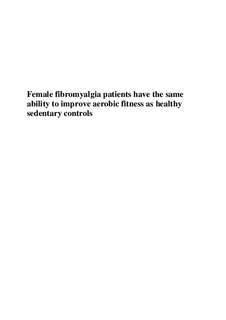Female fibromyalgia patients have the same ability to improve aerobic fitness as healthy sedentary controls
Master thesis
Permanent lenke
http://hdl.handle.net/11250/271467Utgivelsesdato
2010Metadata
Vis full innførselSamlinger
Sammendrag
Background: Several cross-sectional studies have reported lower aerobic fitness among fibromyalgia (FM) patients compared to healthy controls. At present it is unknown whether the inferior aerobic fitness is a cause or a consequence of the illness.
Objective: To examine if female FM patients have the same ability to enhance their aerobic fitness as healthy sedentary controls matched on age and BMI. A second objective was to investigate whether the FM patients experience an increase in pressure pain threshold (PPT) following an aerobic exercise program.
Methods: Fifty subjects (25 FM patients, 25 controls) were enrolled to a 12 week aerobic exercise program. The exercise program consisted of ergometer cycling two times a week (each session 45-55 min) at low to moderate intensity. An incremental ergometer test was performed to determine anaerobic threshold (AT), and exercise intensity was deduced from the AT data acquired. Main outcome was changes in spirometric values and watt production at AT. Second outcome was changes in PPTs measured by an algometer.
Results: FM patients were equally exercisable as healthy matched sedentary controls. No significant differences were found in average changes in VO2 (P=0.53) and watt production (P=0.56) at AT following the exercise program. However, FM patients had lower VO2 and watt production compared to controls at both the pre- and post test (P<0.03 for all comparisons). No significant increase in PPT was observed within the FM group following the exercise program (P>0.1 for all recorded PPT sits).
Discussion: Aerobic exercise with low to moderate intensity enhances aerobic fitness in FM patients to the same extent as in healthy sedentary controls. A substantial lower aerobic fitness was found in the FM patients at both pre- and post test. These findings indicate that the common observation of low aerobic fitness among FM patients is related to inactivity rather than the illness.
